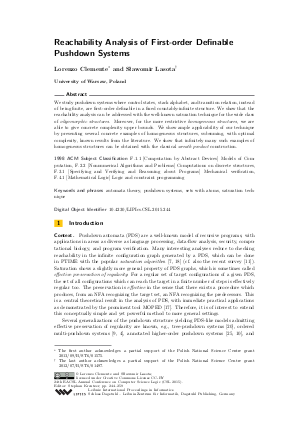Reachability Analysis of First-order Definable Pushdown Systems
Authors Lorenzo Clemente, Slawomir Lasota
-
Part of:
Volume:
24th EACSL Annual Conference on Computer Science Logic (CSL 2015)
Part of: Series: Leibniz International Proceedings in Informatics (LIPIcs)
Part of: Conference: Computer Science Logic (CSL) - License:
 Creative Commons Attribution 3.0 Unported license
Creative Commons Attribution 3.0 Unported license
- Publication Date: 2015-09-07
File

PDF
LIPIcs.CSL.2015.244.pdf
- Filesize: 0.51 MB
- 16 pages
Document Identifiers
Subject Classification
Keywords
- automata theory
- pushdown systems
- sets with atoms
- saturation technique
Metrics
- Access Statistics
-
Total Accesses (updated on a weekly basis)
0PDF Downloads0Metadata Views
Abstract
We study pushdown systems where control states, stack alphabet, and transition relation, instead of being finite, are first-order definable in a fixed countably-infinite structure. We show that the reachability analysis can be addressed with the well-known saturation technique for the wide class of oligomorphic structures. Moreover, for the more restrictive homogeneous structures, we are able to give concrete complexity upper bounds. We show ample applicability of our technique by presenting several concrete examples of homogeneous structures, subsuming, with optimal complexity, known results from the literature. We show that infinitely many such examples of homogeneous structures can be obtained with the classical wreath product construction.
Cite As Get BibTex
Lorenzo Clemente and Slawomir Lasota. Reachability Analysis of First-order Definable Pushdown Systems. In 24th EACSL Annual Conference on Computer Science Logic (CSL 2015). Leibniz International Proceedings in Informatics (LIPIcs), Volume 41, pp. 244-259, Schloss Dagstuhl – Leibniz-Zentrum für Informatik (2015)
https://doi.org/10.4230/LIPIcs.CSL.2015.244
BibTex
@InProceedings{clemente_et_al:LIPIcs.CSL.2015.244,
author = {Clemente, Lorenzo and Lasota, Slawomir},
title = {{Reachability Analysis of First-order Definable Pushdown Systems}},
booktitle = {24th EACSL Annual Conference on Computer Science Logic (CSL 2015)},
pages = {244--259},
series = {Leibniz International Proceedings in Informatics (LIPIcs)},
ISBN = {978-3-939897-90-3},
ISSN = {1868-8969},
year = {2015},
volume = {41},
editor = {Kreutzer, Stephan},
publisher = {Schloss Dagstuhl -- Leibniz-Zentrum f{\"u}r Informatik},
address = {Dagstuhl, Germany},
URL = {https://drops.dagstuhl.de/entities/document/10.4230/LIPIcs.CSL.2015.244},
URN = {urn:nbn:de:0030-drops-54185},
doi = {10.4230/LIPIcs.CSL.2015.244},
annote = {Keywords: automata theory, pushdown systems, sets with atoms, saturation technique}
}
Author Details
References
-
P. A. Abdulla, M. F. Atig, and J. Stenman. Dense-timed pushdown automata. In Proc. of LICS'12, pages 35-44, june 2012.

-
Parosh Aziz Abdulla, Mohamed Faouzi Atig, and Jonathan Cederberg. Timed lossy channel systems. In Proc. of FSTTCS'12, volume 18 of LIPIcs, pages 374-386, 2012.

-
Parosh Aziz Abdulla and Aletta Nylén. Timed Petri nets and BQOs. In Proc. of ICATPN'01, pages 53-70, 2001.

-
Mohamed F. Atig. Model-checking of ordered multi-pushdown automata. Log. Methods Comput. Sci., 8(3), 09 2012.

-
Mikołaj Bojańczyk, Bartek Klin, and Sławomir Lasota. Automata theory in nominal sets. Logical Methods in Computer Science, 10(3:4):paper 4, 2014.

-
Benedikt Bollig, Aiswarya Cyriac, Paul Gastin, and K. Narayan Kumar. Model checking languages of data words. In Lars Birkedal, editor, Proc. of FOSSACS'12, volume 7213 of LNCS, pages 391-405. Springer, 2012.

-
Ahmed Bouajjani, Javier Esparza, and Oded Maler. Reachability analysis of pushdown automata: Application to model-checking and saturation method. In Proc. of CONCUR'97, volume 1243 of LNCS, pages 135-150, 1997.

-
Ahmed Bouajjani, Peter Habermehl, Yan Jurski, and Mihaela Sighireanu. Rewriting systems with data. In In Proc. of FCT'07, volume 4639 of LNCS, pages 1-22. Springer, 2007.

-
Luca Breveglieri, Alessandra Cherubini, Claudio Citrini, and Stefano Crespi-Reghizzi. Multi-push-down languages and grammars. Int. J. Found. Comput. Sci., 7(3):253-292, 1996.

-
Chris Broadbent, Arnaud Carayol, Matthew Hague, and Olivier Serre. A saturation method for collapsible pushdown systems. In Proc. of ICALP'12, volume 7392 of LNCS, pages 165-176, 2012.

-
Arnaud Carayol and Matthew Hague. Saturation algorithms for model-checking pushdown systems. In Proc. of AFL'14, volume 151 of EPTCS, pages 1-24, 5 2014.

-
Edward Y. C. Cheng and Michael Kaminski. Context-free languages over infinite alphabets. Acta Inf., 35(3):245-267, 1998.

-
L. Clemente and S. Lasota. Timed pushdown automata revisited. In Proc. of LICS'15, 2015. Accepted for publication.

-
Wojciech Czerwiński, Piotr Hofman, and Sławomir Lasota. Reachability problem for weak multi-pushdown automata. Logical Methods in Computer Science, 9(3:13):1-29, 2013.

-
Stéphane Demri and Ranko Lazic. LTL with the freeze quantifier and register automata. ACM Trans. Comput. Logic, 10(3):16:1-16:30, April 2009.

-
Alin Deutsch, Richard Hull, Fabio Patrizi, and Victor Vianu. Automatic verification of data-centric business processes. In Proc. of ICDT'09, pages 252-267, New York, NY, USA, 2009. ACM.

-
Javier Esparza and Stefan Schwoon. A BDD-based model checker for recursive programs. In Proc. of CAV'01, CAV'01, pages 324-336. Springer-Verlag, 2001.

-
Alain Finkel, Bernard Willems, and Pierre Wolper. A direct symbolic approach to model checking pushdown systems. In Proc. of INFINITY'97, volume 9, pages 27-37, 1997.

-
R. Fraïssé. Theory of relations. North-Holland, 1953.

-
Irène Guessarian. Pushdown tree automata. Theor. Comp. Sys., 16:237-263, 1983.

-
Ward Henson. Countable homogeneous relational structures and ℵ₀-categorical theories. J. Symb. Logic, 37:494–500, 1972.

-
Slawomir Lasota and Igor Walukiewicz. Alternating timed automata. ACM Trans. Comput. Logic, 9(2):10:1-10:27, 2008.

-
Ranko Lazic, Tom Newcomb, Joël Ouaknine, A. W. Roscoe, and James Worrell. Nets with tokens which carry data. In Proc. of ICATPN'07, LNCS, pages 301-320. Springer-Verlag, 2007.

-
Dugald Macpherson. A survey of homogeneous structures. Discrete Mathematics, 311(15):1599–1634, 2011.

-
A. N. Maslov. Multilevel stack automata. Probl. Peredachi Inf., 12(1):55-62, 1976.

-
Andrzej S. Murawski, Steven J. Ramsay, and Nikos Tzevelekos. Reachability in pushdown register automata. In MFCS 2014, pages 464-473, 2014.

-
Joel Ouaknine and James Worrell. On the language inclusion problem for timed automata: Closing a decidability gap. In In Proc. of LICS'04, pages 54-63. IEEE Computer Society, 2004.

